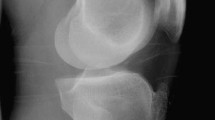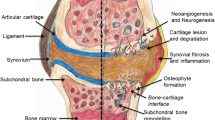Abstract
Cartilage lesions are considered to be the first cause of disability in the active population. Treating cartilage injuries is often a challenge for orthopaedic surgeons, owing to the poor regenerative potential of chondrocytes. Pulsed electromagnetic fields (PEMFs) improve cellular proliferation and migration, and ECM induction. PEMFs during or after surgery for chondral lesion have been demonstrated to be useful in inducing better repair and migration of chondrocytes into the bioscaffolds, and to lead to improvement in patient symptoms after surgery. In this review of the literature, we collected a significative number of studies, which support using biophysical stimulation, in particular PEMFs, as first-line treatment during and after surgery to treat chondral lesion.



Similar content being viewed by others
Bibliografia
Emans PJ, van Rhijn LW, Welting TJ et al. (2010) Autologous engineering of cartilage. Proc Natl Acad Sci USA 107:3418–3423
Vijayan S, Bentley G, Briggs TW et al. (2010) Cartilage repair: A review of Stanmore experience in the treatment of osteochondral defects in the knee with various surgical techniques. Indian J Orthop 44:238–245
Ramsey DK, Russell ME (2009) Unloader braces for medial compartment knee osteoarthritis: implications on mediating progression. Sports Health 1:416–426
Kurtz S, Ong K, Lau E et al. (2007) rojections of primary and revision hip and knee arthroplasty in the United States from 2005 to 2030. J Bone Jt Surg, Am 89:780–785
Redman SN, Oldfield SF, Archer CW (2005) Current strategies for articular cartilage repair. Eur Cells Mater 9:23–32
Ahmed TA, Hincke MT (2010) Strategies for articular cartilage lesion repair and functional restoration. Tissue Eng, Part B, Rev 16:305–329
Butler DL, Goldstein SA, Guilak F (2000) Functional tissue engineering: the role of biomechanics. J Biomech Eng 122:570–575
Butler DL, Shearn JT Juncosa N et al. (2004) Functional tissue engineering parameters toward designing repair and replacement strategies. Clin Orthop Relat Res 427(Suppl):190–199
Butler DL, Juncosa-Melvin N, Boivin GP et al. (2008) Functional tissue engineering for tendon repair: A multidisciplinary strategy using mesenchymal stem cells, bioscaffolds, and mechanical stimulation. J Orthop Res 26:1–9
Fioravanti A, Nerucci F, Collodel G et al. (2002) Biochemical and morphological study of human articular chondrocytes cultivated in the presence of pulsed signal therapy. Ann Rheum Dis 61:1032–1033
De Mattei M, Pasello M, Pellati A et al. (2003) Effects of electromagnetic fields on proteoglycan metabolism of bovine articular cartilage explants. Connect Tissue Res 44:154–159
Bobacz K, Graninger WB, Amoyo L, Smolen JS (2006) Effect of pulsed electromagnetic fields on proteoglycan biosynthesis of articular cartilage is age dependent. Ann Rheum Dis 65:949–951
Ongaro A, Pellati A, Masieri FF et al. (2011) Chondroprotective effects of pulsed electromagnetic fields on human cartilage explants. Bioelectromagnetics 32:543–551
Ongaro A, Varani K, Masieri FF et al. (2012) Electromagnetic fields (EMFs) and adenosine receptors modulate prostaglandin E(2) and cytokine release in human osteoarthritic synovial fibroblasts. J Cell Physiol 227:2461–2469
Stolfa S, Skorvánek M, Stolfa P et al. (2007) Effects of static magnetic field and pulsed electromagnetic field on viability of human chondrocytes in vitro. Physiol Res 56(Suppl 1):S45–49
Martel-Pelletier J, Pelletier JP (2010) Is osteoarthritis a disease involving only cartilage or other articular tissues? Eklem Hastalik Cerrahisi 21:2–14
Chang SH, Hsiao YW, Lin HY (2011) Low-frequency electromagnetic field exposure accelerates chondrocytic phenotype expression on chitosan substrate. Orthopedics 34:20
De Mattei M, Varani K, Masieri FF et al. (2009) Adenosine analogs and electromagnetic fields inhibit prostaglandin E2 release in bovine synovial fibroblasts. Osteoarthr Cartil 17:252–262
Benazzo F, Cadossi M, Cavani F et al. (2008) Cartilage repair with osteochondral autografts in sheep: effect of biophysical stimulation with pulsed electromagnetic fields. J Orthop Res 26:631–642
Zorzi C, Dall’Oca C, Cadossi R, Setti S (2007) Effects of pulsed electromagnetic fields on patients’ recovery after arthroscopic surgery: prospective, randomized and double-blind study. Knee Surg Sports Traumatol Arthrosc 15:830–834
Massari L, Cadossi R, Traina GC, for the study CRES group (2008) Impiego della stimolazione biofisica per l’osteogenesi riparativa e per la condroprotezione articolare GIOT 34(Suppl 1):S171–175
Author information
Authors and Affiliations
Corresponding author
Ethics declarations
Conflitto di interesse
Gli autori A. D’Addona, A. Izzo, L. Ruosi, A. Santulli, C. Ruosi dichiarano di non aver alcun conflitto d’interesse.
Consenso informato e conformità agli standard etici
Tutte le procedure descritte nello studio e che hanno coinvolto essere umani sono state attuate in conformità alle norme etiche stabilite dalla dichiarazione di Helsinki del 1975 e successive modifiche. Il consenso informato è stato ottenuto da tutti i pazienti inclusi nello studio.
Human and Animal Rights
L’articolo non contiene alcuno studio eseguito su esseri umani e su animali da parte degli autori.
Rights and permissions
About this article
Cite this article
D’Addona, A., Izzo, A., Ruosi, L. et al. Medicina rigenerativa in ortopedia e traumatologia: la stimolazione biofisica. LO SCALPELLO 33, 195–200 (2019). https://doi.org/10.1007/s11639-019-00339-7
Published:
Issue Date:
DOI: https://doi.org/10.1007/s11639-019-00339-7




